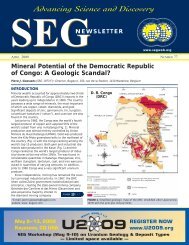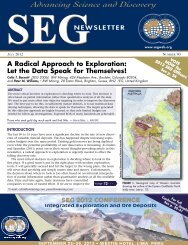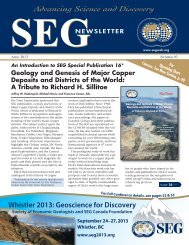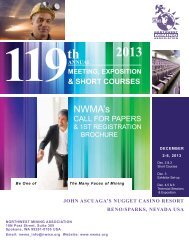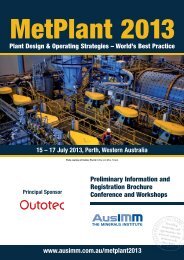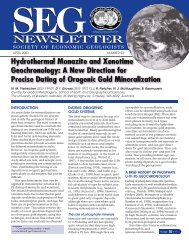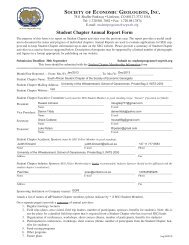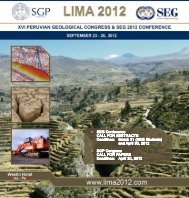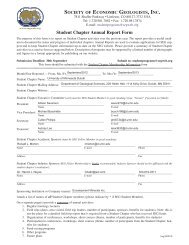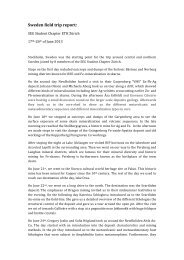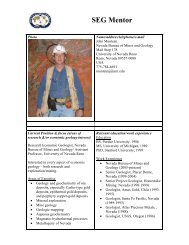SEG 45 Final_qx4 - Society of Economic Geologists
SEG 45 Final_qx4 - Society of Economic Geologists
SEG 45 Final_qx4 - Society of Economic Geologists
You also want an ePaper? Increase the reach of your titles
YUMPU automatically turns print PDFs into web optimized ePapers that Google loves.
12 <strong>SEG</strong> NEWSLETTER No 55 • OCTOBER 2003<br />
... from 11<br />
The Golden Triangle <strong>of</strong> Southeast China: Another Carlin Trend? (Continued)<br />
alteration and ore assemblages is a<br />
clear indication that similar chemical<br />
processes occurred in both regions.<br />
However, there are also significant differences,<br />
particularly in their deformational<br />
and magmatic history. There is<br />
good evidence that the deposits <strong>of</strong><br />
norhteastern Nevada were generated<br />
during the Tertiary, a period <strong>of</strong> high<br />
heat flow accompanying extension and,<br />
perhaps, a mantle plume event.<br />
Although there is a need for high-quality,<br />
absolute dating <strong>of</strong> the Chinese<br />
deposits, the available evidence points<br />
to their association with Cretaceous<br />
compression. This leads to the proposition<br />
that a specific regional fluid flow<br />
regime (be it topography, deformation<br />
or thermally driven) is less important<br />
than the chemical characteristics <strong>of</strong> the<br />
host sequence and the local physicochemical<br />
controls on ore deposition.<br />
Could the Golden Triangle host a<br />
cluster <strong>of</strong> deposits with similar gold<br />
endowment to the Carlin trend? There<br />
are three factors that suggest an answer<br />
to this question. First, the Golden<br />
Triangle lacks a large volume <strong>of</strong> the<br />
ideal host rocks (as defined by H<strong>of</strong>stra<br />
and Cline, 2000). Secondly, the Gold<br />
Triangle presents an “inverse” hydrodynamic<br />
regime compared to the Carlin<br />
trend in that the aquitard or seal units<br />
(siliciclastics) are beneath rather than<br />
above the potential host limestone<br />
sequence. Thirdly, it is likely that the<br />
multiple deformation events and presence<br />
<strong>of</strong> intrusions as mechanical inhomogeneities<br />
in northeast Nevada have<br />
contributed to a greater overall porosity<br />
and permeability there, compared to<br />
the Golden Triangle. On the basis <strong>of</strong><br />
these factors, it seems that the Golden<br />
Triangle is likely to be less well endowed<br />
with gold than Nevada.<br />
REFERENCES<br />
Armstrong, A.K., Theodore, T.G., Oscarson,<br />
R.L., Kotlyar, B.B., Harris, A.G., Bettles,<br />
K.H., Lauha, E.A., Hipsley, R.A., Griffin,<br />
G.L., Abbott, E.W., and Cluer, J.K., 1998,<br />
Preliminary facies analysis <strong>of</strong> Silurian and<br />
Devonian autochthonous rocks that host<br />
gold along the Carlin trend, Nevada: USGS<br />
Open File Report 98-338, p. 38–68.<br />
Ashley, R.P., Cunningham, C.G., Bostock,<br />
N.H., Dean W.E., and Chou, I-M., 1991,<br />
Geology and geochemistry <strong>of</strong> three sedimentary<br />
rock-hosted disseminated gold<br />
deposits in Guizhou Province, People’s<br />
Republic <strong>of</strong> China: Ore Geology Reviews,<br />
v. 6, p. 133–151.<br />
Cook, H., 1988, Overview: Geologic history<br />
and carbonate petroleum reservoirs <strong>of</strong> the<br />
Basin and Range Province, Western United<br />
States: Carbonate Symposium, Denver,<br />
Colorado, Rocky Mountain Association <strong>of</strong><br />
<strong>Geologists</strong>, p. 213–227.<br />
Cooke, A., 1998, South China gold project:<br />
Structural and stratigraphic setting <strong>of</strong> gold<br />
mineralisation in the Nam Pan Jiang<br />
basin, Southern China: Unpublished report<br />
to BHP Minerals, Brisbane, Australia,<br />
unpaginated.<br />
Emsbo, P., Hutchinson, R.W., H<strong>of</strong>stra, A.H.,<br />
Volk J.A., Bettles, K.H., Baschuk, G.J., and<br />
Johnson, C.A., 1999, Syngenetic Au on the<br />
Carlin trend: Implications for Carlin-type<br />
deposits: Geology, v. 27, p. 59–62.<br />
Farmer, G.L., and De Paolo, D. J., 1983,<br />
Origin <strong>of</strong> Mesozoic and Tertiary granite in<br />
the western United States and implications<br />
for pre-Mesozoic crustal structure. 1. Nd<br />
and Sr isotopic studies in the geocline <strong>of</strong> the<br />
northern Great Basin: Journal <strong>of</strong><br />
Geophysical Research, v. 88, p. 3379–3401.<br />
H<strong>of</strong>stra, A. and Cline, J., 2000, Characteristics<br />
and models for Carlin-type gold deposits:<br />
Reviews in <strong>Economic</strong> Geology, v. 13, p.<br />
163–220.<br />
Li, Z. and Peters, S., 1998, Comparative geology<br />
and geochemistry <strong>of</strong> sedimentary rockhosted<br />
(Carlin-type) gold deposits in the<br />
People’s Republic <strong>of</strong> China and in Nevada,<br />
USA: USGS Open-File Report OF 98-0466,<br />
p. 160.<br />
Lou, Xiaohuan, 1998, Geological characteristics,<br />
forming mechanism and prospect on<br />
the Lannigou gold deposit in Zhengfeng<br />
County, Guizhou Province: in Li, Zhiping<br />
and Peters S., eds., USGS Open File Report<br />
98-466, p. 129–152.<br />
Peters, S.G., Ferdock G.C., Woitsekhowskaya<br />
M.B., Leonardson R., and Rahn, J., 1998,<br />
Oreshoot zoning in the Carlin-type Betze<br />
orebody, Goldstrike mine, Eureka County,<br />
Nevada: USGS Open File Report 98-620,<br />
49 p.<br />
Stenger, D.P., Kesler, S.E., Peltonen, D.R. and<br />
Tapper, C.J., 1998, Deposition <strong>of</strong> gold in<br />
Carlin-type deposits: The role <strong>of</strong> sulfidation<br />
and decarbonation at Twin Creeks:<br />
<strong>Economic</strong> Geology, v. 93, p. 201–215.<br />
Teal, L., Jackson, M., 1997, Geologic<br />
overview <strong>of</strong> the Carlin trend gold deposits<br />
and description <strong>of</strong> recent deep discoveries:<br />
<strong>SEG</strong> Newsletter, no. 31, p. 1, 13–25.<br />
Wilde, A.R. and Muhling, P., 2000,<br />
Comparison between the Lennard Shelf<br />
MVT province <strong>of</strong> Western Australia and the<br />
Carlin trend <strong>of</strong> Nevada: Implications for<br />
genesis and exploration, in Cluer J.K. et al.,<br />
eds., Geology and Ore Deposits 2000: The<br />
Great Basin and beyond: Proceedings <strong>of</strong> the<br />
Geological <strong>Society</strong> <strong>of</strong> Nevada, Reno, May<br />
2000, p. 769–781.<br />
Wooden, J.L., Tosdal, R.M., and Kistler, R.W.,<br />
1997, Pb and Sr isotopic mapping <strong>of</strong> crustal<br />
structure in the northern Great Basin: <strong>SEG</strong><br />
Guidebook Series, v. 28, p. 47–51. 1<br />
Joseph A. Laravie<br />
135 Flora Place<br />
Spring Creek, NV 89815<br />
jlaravie@frontiernet.net<br />
775-777-8223<br />
Geologist<br />
GIS Programmer<br />
Mapinfo - MapBasic<br />
ArcView - Avenue<br />
Ag<br />
NEVADA 24K QUAD GEOLOGY MAPS IN GIS VECTOR FORMATS<br />
PAID ADVERTISEMENT<br />
PAID ADVERTISEMENT



